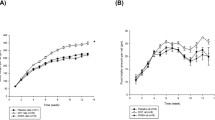Abstract
Traditionally, in women, only the theca cells in the ovary and the zona reticularis layer of the adrenal cortex are believed to synthesize androgens. Interestingly, their neighboring cell layers, the granulosa cells and the zona glomerulosa cells, respectively, do not produce androgens. Recent literature has highlighted the role of the activator protein (AP-1) transcription factor, c-Fos, in the dynamics of this structural and functional relationship. Differential expression of c-Fos is believed to result in distinct patterns of steroidogenesis among these compartments in both the ovary and the adrenal glands. Clinically, deficient c-Fos levels have been implicated in the pathogenesis of polycystic ovary syndrome (PCOS). In this review, we discuss the pivotal role of c-Fos in controlling the expression of CYP17 and hence androgen production in various organ systems throughout the human body.
Similar content being viewed by others
References
Suzuki T, Sasano H, Tamura M, et al. Temporal and spatial localization of steroidogenic enzymes in premenopausal human ovaries: in situ hybridization and immunohistochemical study. Mol Cell Endocrinol. 1993;97(1–2):135–143.
Short RV. Steroids in the follicular fluid and the corpus luteum of the mare. A ‘two-cell type’ theory of ovarian steroid synthesis. J Endocrinol. 1962;24:59–63.
McNatty KP, Makris A, DeGrazia C, Osathanondh R, Ryan KJ. The production of progesterone, androgens, and estrogens by granulosa cells, thecal tissue, and stromal tissue from human ovaries in vitro. J Clin Endocrinol Metab. 1979;49(5):687–699.
Carr BR, Blackwell RE, Azziz R. Essential Reproductive Medicine. New York, NY: McGraw-Hill, Medical Pub. Div; 2005.
Carr BR, McGee EA, Sawetawan C, Clyne CD, Rainey WE. The effect of transforming growth factor-beta on steroidogenesis and expression of key steroidogenic enzymes with a human ovarian thecal-like tumor cell model. Am J Obstet Gynecol. 1996;174(4):1109–1116; discussion 1116–1107.
Daneshmand S, Weitsman SR, Navab A, Jakimiuk AJ, Magoffin DA. Overexpression of theca-cell messenger RNA in polycystic ovary syndrome does not correlate with polymorphisms in the cholesterol side-chain cleavage and 17alphahydroxylase/C(17-20) lyase promoters. Fertil Steril. 2002;77(2):274–280.
Nelson VL, Legro RS, Strauss JF 3rd, McAllister JM. Augmented androgen production is a stable steroidogenic phenotype of propagated theca cells from polycystic ovaries. Mol Endocrinol. 1999;13(6):946–957.
Wood JR, Dumesic DA, Abbott DH, Strauss JF 3rd. Molecular abnormalities in oocytes from women with polycystic ovary syndrome revealed by microarray analysis. J Clin Endocrinol Metab. 2007;92(2):705–713.
Beshay VE, Havelock JC, Sirianni R, et al. The mechanism for protein kinase C inhibition of androgen production and 17alpha-hydroxylase expression in a theca cell tumor model. J Clin Endocrinol Metab. 2007;92(12):4802–4809.
Corbalan-Garcia S, Gomez-Fernandez JC. Protein kinase C regulatory domains: the art of decoding many different signals in membranes. Biochim Biophys Acta. 2006;1761(7):633–654.
Angel P, Karin M. The role of Jun, Fos and the AP-1 complex in cell-proliferation and transformation. Biochim Biophys Acta. 1991;1072(2–3):129–157.
Jansen E, Laven JS, Dommerholt HB, et al. Abnormal gene expression profiles in human ovaries from polycystic ovary syndrome patients. Mol Endocrinol. 2004; 18(12):3050–3063.
Shea-Eaton W, Sandhoff TW, Lopez D, Hales DB, McLean MP. Transcriptional repression of the rat steroidogenic acute regulatory (StAR) protein gene by the AP-1 family member c-Fos. Mol Cell Endocrinol. 2002;188(1–2):161–170.
Jo Y, King SR, Khan SA, Stocco DM. Involvement of protein kinase C and cyclic adenosine 3,′5′-monophosphate-dependent kinase in steroidogenic acute regulatory protein expression and steroid biosynthesis in Leydig cells. Biol Reprod. 2005;73(2): 244–255.
Guo IC, Huang CY, Wang CK, Chung BC. Activating protein-1 cooperates with steroidogenic factor-1 to regulate 3,′5′-cyclic adenosine 5’-monophosphate-dependent human CYP11A1 transcription in vitro and in vivo. Endocrinology. 2007;148(4): 1804–1812.
Patel SS, Beshay VE, Escobar JC, Suzuki T, Carr BR. Molecular mechanism for repression of 17alpha-hydroxylase expression and androstenedione production in granulosa cells. J Clin Endocrinol Metab. 2009;94(12):5163–5168.
Oktay M, Wary KK, Dans M, Birge RB, Giancotti FG. Integrinmediated activation of focal adhesion kinase is required for signaling to Jun NH2-terminal kinase and progression through the G1 phase of the cell cycle. J Cell Biol. 1999;145(7):1461–1469.
Oktay KH, Oktay MH. Immunohistochemical analysis of tyrosine phosphorylation and AP-1 transcription factors c-Jun, Jun D, and Fos family during early ovarian follicle development in the mouse. Appl Immunohistochem Mol Morphol. 2004;12(4): 364–369.
Wickenheisser JK, Quinn PG, Nelson VL, Legro RS, Strauss JF 3rd, McAllister JM. Differential activity of the cytochrome P450 17alpha-hydroxylase and steroidogenic acute regulatory protein gene promoters in normal and polycystic ovary syndrome theca cells. J Clin Endocrinol Metab. 2000;85(6):2304–2311.
Woods DC, Haugen MJ, Johnson AL. Actions of epidermal growth factor receptor/mitogen-activated protein kinase and protein kinase C signaling in granulosa cells from Gallus gallus are dependent upon stage of differentiation. Biol Reprod. 2007;77(1):61–70.
Cheng RX, Feng DY, Zheng H, Tan Y. [Effect of activation of p-MAPK on activating c-fos and c-jun proteins in breast cancer]. Hunan Yi Ke Da Xue Xue Bao. 2001;26(1):10–12.
Dharia S, Slane A, Jian M, Conner M, Conley AJ, Parker CR Jr. Colocalization of P450c17 and cytochrome b5 in androgen-synthesizing tissues of the human. Biol Reprod. 2004;71(1):83–88.
Author information
Authors and Affiliations
Corresponding author
Rights and permissions
About this article
Cite this article
Patel, S.S., Beshay, V.E., Escobar, J.C. et al. 17α-Hydroxylase (CYP17) Expression and Subsequent Androstenedione Production in the Human Ovary. Reprod. Sci. 17, 978–986 (2010). https://doi.org/10.1177/1933719110379055
Published:
Issue Date:
DOI: https://doi.org/10.1177/1933719110379055




